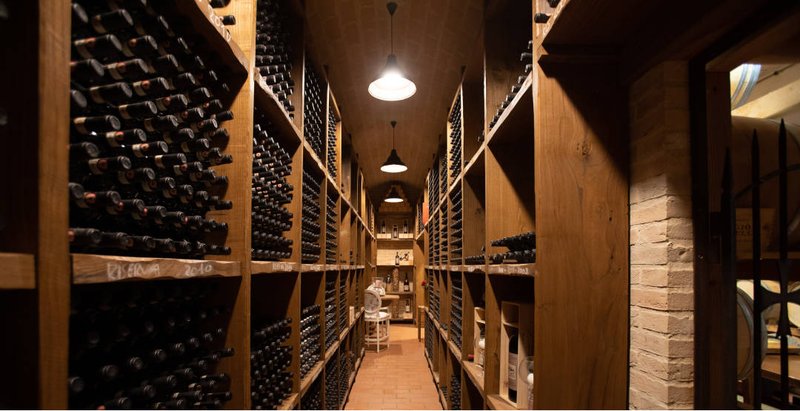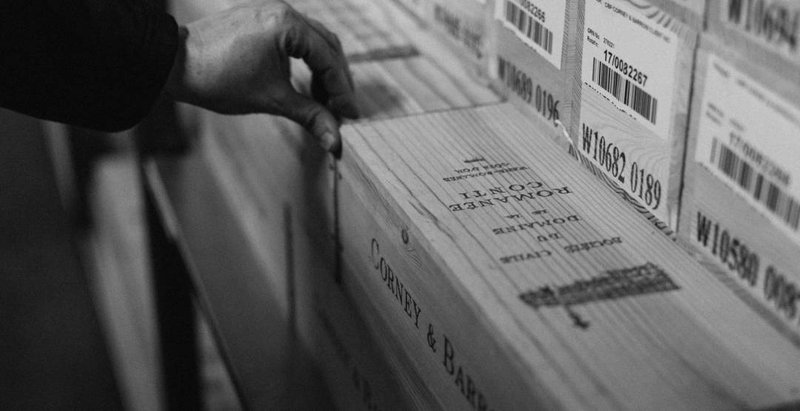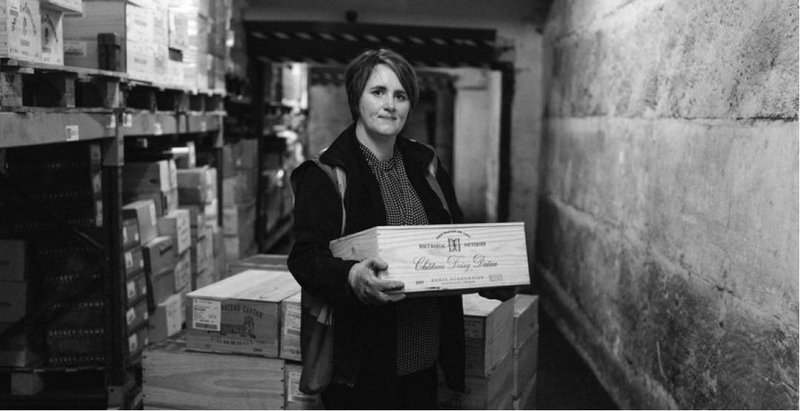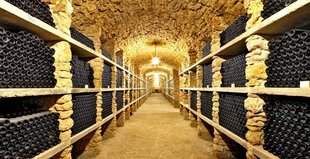The Ultimate Guide To Wine Storage (2025)
Looking for the best way to store your wine?
Building a Wine Collection takes considerable time, money, and effort.
And, climate-controlled wine storage is an essential aspect without which your precious bottles may lose their taste and market value over time.
So how do you store wine under optimal conditions? And, is creating a wine storage facility on your own an easy process?
In this article, we’ll tell you all you need to know about proper wine storage and the perfect conditions to store your wine. You’ll also find out the easiest and most cost-effective way to store your wine bottles!
Further reading
- Are you a red wine lover? Then check out these Amazing Pinot Noir and Merlot Wines.
- Or if you prefer whites, this Pinot Grigio Guide is for you.
Why Do You Need To Store Wine Properly?

Wine, once exposed to oxygen, can quickly lose its flavor because of oxidation and spoilage by aerobic microorganisms.
But, unopened bottles are just as sensitive to these environmental factors:
Light
Direct sunlight or artificial light can react with phenolic compounds in the wine and spoil it.
White wine, sparkling wine, and rosés are more susceptible to light-related damage. This is why you’d find most wines bottled in tinted glassware.
Temperature
Most wines react to heat by aging faster. Typically, wines need to be stored at a constant temperature of 10 to 15 °C (50 to 59 °F).
On the other hand, a very low storage temperature can cause the wine to freeze and damage the bottle and the cork.
Humidity
Optimal humidity (around 50-70%) can keep the cork from drying out and prevents any exposure to oxygen. On the other hand, too much of it can cause mold to form on the cork and the labels to get smudged.
Vibration
Sudden movement (and even loud sounds) in the wine storage area can stir the sediments. The resulting reaction can cause the wine to become too sweet, less aromatic, or less acidic.
To protect your valuable wine from these environmental factors, you’ll need to take extra care when selecting a space to store wine in.
Here are some tips to remember:
8 Essential Tips For Storing Wine
These pointers will help you design the perfect wine storage for your collection.
1. Store at the right temperature

The optimal wine storage temperature is around 13ºC.
But in practice, most wines have different needs. For example, red wine needs to be stored at 12 to 19˚C (53 to 66 ˚F) while champagne needs cooler temperature zones.
However, no wine should be allowed to freeze or heat above 20°C (68 ˚F). Storing it for the long run rules out any kind of kitchen countertop wine rack or your normal refrigerator.
Plus, too many temperature fluctuations can ruin your wine. So avoid taking it out of storage too often to allow it to remain at a constant temperature.
2. Use a wine refrigerator, not a regular fridge
Conditions in your kitchen refrigerator are not ideal for long-term wine storage for the following reasons:
- It maintains temperatures close to or below 4°C (39 ˚F). This will freeze your wine and prevent it from aging well.
- Once frozen, the wine can begin to push out the cork - exposing it to oxygen.
- Humidity levels in a refrigerator are very low and can fluctuate several degrees over the course of a day.
- Exposure to food and other beverages can cause cross-contamination from odors.
If you want to store wine for long periods, you need to invest in a wine refrigerator. It maintains steady humidity levels and a constant temperature level of 10 to 15˚C (50 to 59˚F).
3. Store the bottles horizontally

Store your corked bottles horizontally to keep the corks moist. This will also prevent oxygen from getting into the bottle.
If you have a large collection, horizontal wine holders will also save you a lot of storage space!
However, if your bottle caps are made up of metal or plastic, you may store them as you wish to.
4. Protect from vibration

If you’re storing your bottle outside a proper cellar, be aware that even small movements and sounds will cause vibrations in your wine, altering its aging process.
Even in a cellar, your collection isn’t entirely safe from vibrations. This is true, especially if you live near a subway or a highway.
If you’re constrained for space, you can simply wrap your bottles in Styrofoam or bubble wrap and place it in a room that you rarely use. Moreover, avoid picking them up or moving them around too often.
5. Maintain the right humidity
Starting from as early as 6000 BC, wine lovers have been known to find intriguing places to store their treasured wines - in terracotta jugs underground, in a wine cave, or in underground wine rooms.
A modern wine cellar may not be as dramatic, but it also recreates similar storage conditions, including maintaining an optimal humidity level.
If you live in a dry region, keeping a pan of water or sprinkling your cellar floor with a little water will help. But if you live in high humidity regions, you might want to invest in dehumidifiers.
6. Make sure the amount of light is ideal

Even if you’re going to drink your wine within a few days, direct or excessive light is a complete no-no.
You can place them in a carton or cover them in towels. Use lighting that is low-intensity and generates low amounts of heat - for example, LED lights and low-voltage wall sconces.
In the long run, you will need to stow them away from any strong natural or artificial light.
7. Storing open bottles
It’s best to minimize the number of times you open a bottle.
If you wish to open a bottle to enjoy a glass of your favorite wine, make sure you have the right wine accessories like a bottle opener, decanter, and stemware on your wine glass rack.
Also, remember to close the bottle tightly before you put it back into your storage. You can do this by:
- Covering the cork with wax paper to allow the cork to settle back into its original position
- Using rubber stoppers (in case of missing or damaged corks)
- Using a wine vacuum pump to suck out all air inside the bottle
Once you’ve closed it, place it back in the cooler under the same storage temperature and humidity as before.
The kind of storage space you need depends on the nature of wines in your collection.
But what are the best ways to store your wine bottles? Read on.
5 Ways To Store Your Wine

Here are some wine storage ideas to inspire you to design the best wine storage unit for your collection.
1. Wine rack
If you have a small collection of bottles that you often replace, a wine storage rack might be the solution for you.
What is a wine rack?
It is a simple stackable, wall-mount, or freestanding installation that can even be placed on the tabletop or countertop. You can find a variety of designs that allow for horizontal and vertical storage.
You could buy a simple wine rack priced from $4 and upwards per bottle.
Pros
A wine bottle rack is the simplest of all wine storage options. A stackable wine rack made with stainless steel or a wooden wine rack can be an interesting addition to your decor.
It’s inexpensive and you don’t need professional help installing it. Place it in your living room or dining room and you can even move it around frequently.
Cons
You cannot control the humidity or the room temperature of wines in the wine rack that comes without a cooling unit. This makes it unsuitable for long-term storage.
2. Wine cooler
If you want to maintain an optimal wine serving temperature, a wine cooler would be a better option.
What is a wine cooler?
It’s a small wine storage unit that maintains temperatures around 10 to 14˚C (50 to 57 ˚F).
A simple 20-120 bottle wine cooler might cost anything from $200 to $2,000.
Pros
Compared to the bigger wine fridges, it’s inexpensive and more convenient to place in small spaces. It’s also ideal for a smaller wine collection that you’re storing for a short period.
Cons
It doesn’t offer any humidity control settings. Also, racking options in wine coolers only have a limited bottle capacity.
3. Wine cabinet or fridge
A wine cabinet or wine refrigerator comes closest to meeting all the long-term wine storage requirements.
What is a wine cabinet or fridge?
The wine cabinet is a sophisticated wine storage unit that offers temperature and humidity control settings.
It could be a metal one or a wooden one that looks like a piece of furniture in the room. It is much larger than a wine rack or cooler. In fact, the display shelves in the largest wine cabinets can hold up to 200 bottles.
A 100-bottle wine cabinet could cost between $500 to $4,000 depending on the materials used and the cooling system. A 500-bottle cabinet could cost you $15,000 to $22,000.
Pros
Wine cabinets are designed to add a vintage charm to your room. The best part is that you can keep upgrading its cooling unit over the years.
Cons:
As home wine storage goes, a wine cabinet is one of the costlier options.
4. Wine cellar or modified wine room
Finally, if you’re an ambitious wine enthusiast and hope to collect more than a few hundred bottles of fine wine, it’s time to start thinking of storing wine in a cellar or a modified wine room.
What is a wine cellar or modified wine room?
A cellar is a small, cool, and damp space in the basement of your house or under a staircase with well-spaced shelving to store your wines in.
You can recreate similar storage conditions in any room in your home or commercial space to create a modified wine room.
Wine rooms like these that are 25-150 square feet in size typically cost around $15,000 - $62,000. This can go upto $100,000 if you include a tasting room.
Remember the general thumb rule that constructing a typical wine cellar will cost you $300 to $600 per square foot. The total cost depends on the storage capacity, design, lighting, cooling system, and materials used for racks, walls, doors, and floors.
Pros
A cellar offers ideal conditions for your wine collection. And since you won’t be using the room for anything else, it ensures that the wine never gets disturbed.
Cons
This kind of wine storage facility is the most space-consuming. It also requires sufficient technical know-how to maintain the ideal storage temperature, humidity, and other optimal conditions.
5. Off-site, professional storage facility
Designing and creating a DIY wine storage facility is time-consuming (may take months!), expensive, and comes with its own risks. And, a few wrong settings can potentially damage your wines forever.
So why take the risk when you can store your precious collection in professional wine storage facilities?
Let’s see how you can do this.
What is an off-site professional storage facility?
These are modern, fully-equipped spaces specially designed to hold a large quantity and range of wines.
They cater to private and commercial collectors, offering a range of services in addition to storage.
Some warehouses also give their customers the choice of a private wine locker or wine storage unit.
You’ll need to pay a fixed fee that includes the cost of utilities and maintenance.
Why should you store wines in a professional storage?
A professional wine storage facility offers you a safe space for your collection under optimal storage conditions.
The service comes with a fixed annual fee that would be way more affordable than building a wine cellar in your home or commercial space.
That’s not all.
You can always have a bottle or two delivered back to you for drinking or selling whenever you want!
Now, let's take that a step further.
What if you could have a trusted wine investment company like Vinovest build a portfolio of investment-grade wines and store them in a bonded warehouse for you?
Let’s see how that works.
Store Your Wines Professionally Through Vinovest

Apart from storing your wines in bonded warehouses, Vinovest buys, authenticates, and even sells your wine bottles for you.
What’s more?
You can even have your bottle delivered to your home if you wish to sip a glass of your favorite Cabernet Sauvignon!
How do you store wines via Vinovest?
Just follow these simple steps.
- Sign up on the Vinovest website.
- Answer questions about your investment preferences and risk appetite.
- Add funds to your account.
- Let the wine professionals at Vinovest buy, store, and sell your bottles according to your preferences - while you track your portfolio online.
Why store wines through Vinovest?
If you’re a serious wine collector, Vinovest can make life easy for you by taking care of all these aspects:
Easy buying and selling
Vinovest’s Artificial Intelligence-based online platform lets you invest in the best wines from around the world. Using proprietary financial models and historical data, this platform creates a balanced portfolio of high performing wines specifically for you.
Optimal storage
With Vinovest, your collection will be in safe hands. Its professional warehouses are strategically located next to the world’s best wine regions, reducing excessive movement and vibration from damaging the wine. These warehouses also maintain perfect light, temperature, vibration, and humidity conditions.
Provenance and authenticity checks
Vinovest goes the extra length to trace your wine’s provenance and to make sure it’s authentic.
Balanced, curated portfolio of wines
A team of Sommeliers and a Master Sommelier will curate a fine wine portfolio based on in-depth research.
Low overall costs
You need to pay a fixed annual 2.5% fee (1.9% for a portfolio above $50,000). This covers buying wines, authentication, storage, a full insurance policy at market value, portfolio management, and selling the wine bottles.
You benefit from Vinovest’s world-class storage facilities at 80% lower prices than any other third-party storage. It is the result of economies of scale and the deep industry relationships that Vinovest has developed over the years.
Ownership
The coolest part is that you own the wines you buy.
Conclusion
Designing and building a wine storage facility for a large wine collection is both complicated and expensive. Without the storage conditions, you’ll potentially damage your wine’s taste and value, ruining your entire investment.
Now, that’s a risk you simply can’t afford to take if you’re a wine lover.
And with a trusted wine investment partner like Vinovest, you won’t have to!
How about signing up right away to create a stellar fine wine portfolio?



